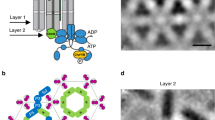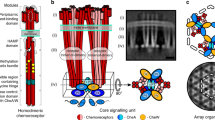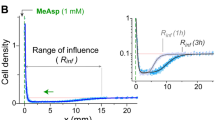Abstract
Bacterial chemotaxis is a model system for signal transduction, noted for its relative simplicity, high sensitivity, wide dynamic range and robustness. Changes in ligand concentrations are sensed by a protein assembly consisting of transmembrane receptors, a coupling protein (CheW) and a histidine kinase (CheA)1,2,3,4. In Escherichia coli, these components are organized at the cell poles in tight clusters that contain several thousand copies of each protein1,4,5,6. Here we studied the effects of variation in the composition of clusters on the activity of the kinase and its sensitivity to attractant stimuli, monitoring responses in vivo using fluorescence resonance energy transfer. Our results indicate that assemblies of bacterial chemoreceptors work in a highly cooperative manner, mimicking the behaviour of allosteric proteins. Conditions that favour steep responses to attractants in mutants with homogeneous receptor populations also enhance the sensitivity of the response in wild-type cells. This is consistent with a number of models7,8,9,10,11 that assume long-range cooperative interactions between receptors as a general mechanism for signal integration and amplification.
This is a preview of subscription content, access via your institution
Access options
Subscribe to this journal
Receive 51 print issues and online access
$199.00 per year
only $3.90 per issue
Buy this article
- Purchase on Springer Link
- Instant access to full article PDF
Prices may be subject to local taxes which are calculated during checkout




Similar content being viewed by others
References
Gegner, J. A., Graham, D. R., Roth, A. F. & Dahlquist, F. W. Assembly of an MCP receptor, CheW, and kinase CheA complex in the bacterial chemotaxis signal transduction pathway. Cell 70, 975–982 (1992)
Boukhvalova, M. S., Dahlquist, F. W. & Stewart, R. C. CheW binding interactions with CheA and Tar. Importance for chemotaxis signaling in Escherichia coli. J. Biol. Chem. 277, 22251–22259 (2002)
Borkovich, K. A., Kaplan, N., Hess, J. F. & Simon, M. I. Transmembrane signal transduction in bacterial chemotaxis involves ligand-dependent activation of phosphate group transfer. Proc. Natl Acad. Sci. USA 86, 1208–1212 (1989)
Ninfa, E. G., Stock, A., Mowbray, S. & Stock, J. B. Reconstitution of the bacterial chemotaxis signal transduction system from purified components. J. Biol. Chem. 266, 9764–9770 (1991)
Maddock, J. R. & Shapiro, L. Polar location of the chemoreceptor complex in the Escherichia coli cell. Science 259, 1717–1723 (1993)
Sourjik, V. & Berg, H. C. Localization of components of the chemotaxis machinery of Esherichia coli using fluorescent protein fusions. Mol. Microbiol. 37, 740–751 (2000)
Bray, D., Levin, M. D. & Morton-Firth, C. J. Receptor clustering as a cellular mechanism to control sensitivity. Nature 393, 85–88 (1998)
Shi, Y. & Duke, T. Cooperative model of bacterial sensing. Phys. Rev. E 58, 6399–6406 (1998)
Duke, T. A. J. & Bray, D. Heightened sensitivity of a lattice of membrane receptors. Proc. Natl Acad. Sci. USA 96, 10104–10108 (1999)
Shimizu, T. S., Aksenov, S. V. & Bray, D. A spatially extended stochastic model of the bacterial chemotaxis signalling pathway. J. Mol. Biol. 329, 291–309 (2003)
Mello, B. A. & Tu, Y. Quantitative modeling of sensitivity in bacterial chemotaxis: the role of coupling among different chemoreceptor species. Proc. Natl Acad. Sci. USA 100, 8223–8228 (2003)
Asakura, S. & Honda, H. Two-state model for bacterial chemoreceptor proteins. The role of multiple methylation. J. Mol. Biol. 176, 349–367 (1984)
Ames, P. & Parkinson, J. S. Constitutively signaling fragments of Tsr, the Escherichia coli serine chemoreceptor. J. Bacteriol. 176, 6340–6348 (1994)
Barkai, N. & Leibler, S. Robustness in simple biochemical networks. Nature 387, 913–917 (1997)
Morton-Firth, C. J., Shimizu, T. S. & Bray, D. A. Free-energy-based stochastic simulation of the Tar receptor complex. J. Mol. Biol. 286, 1059–1074 (1999)
Borkovich, K. A., Alex, L. A. & Simon, M. I. Attenuation of sensory receptor signaling by covalent modification. Proc. Natl Acad. Sci. USA 89, 6756–6760 (1992)
Bornhorst, J. A. & Falke, J. J. Attractant regulation of the aspartate receptor-kinase complex: Limited cooperative interactions between receptors and effects of the receptor modification state. Biochemistry 39, 9486–9493 (2000)
Li, G. & Weis, R. M. Covalent modification regulates ligand binding to receptor complexes in the chemosensory system of Escherichia coli. Cell 100, 357–365 (2000)
Gestwicki, J. E. & Kiessling, L. L. Inter-receptor communication through arrays of bacterial chemoreceptors. Nature 415, 81–84 (2002)
Ames, P., Studdert, C. A., Reiser, R. H. & Parkinson, J. S. Collaborative signaling by mixed chemoreceptor teams in Escherichia coli. Proc. Natl Acad. Sci. USA 99, 7060–7065 (2002)
Levit, M. N. & Stock, J. B. Receptor methylation controls the magnitude of stimulus–response coupling in bacterial chemotaxis. J. Biol. Chem. 277, 36760–36765 (2002)
Sourjik, V. & Berg, H. C. Receptor sensitivity in bacterial chemotaxis. Proc. Natl Acad. Sci. USA 99, 123–127 (2002)
Shimizu, T. S. et al. Molecular model of a lattice of signalling proteins involved in bacterial chemotaxis. Nature Cell Biol. 2, 792–796 (2000)
Levit, M. N., Grebe, T. W. & Stock, J. B. Organization of the receptor–kinase signaling array that regulates Escherichia coli chemotaxis. J. Biol. Chem. 277, 36748–36754 (2002)
Kim, S. H., Wang, W. & Kim, K. K. Dynamic and clustering model of bacterial chemotaxis receptors: structural basis for signaling and high sensitivity. Proc. Natl Acad. Sci. USA 99, 11611–11615 (2002)
Kim, K. K., Yokota, H. & Kim, S. H. Four-helical-bundle structure of the cytoplasmic domain of a serine chemotaxis receptor. Nature 400, 787–792 (1999)
Monod, J., Wyman, J. & Changeux, J.-P. On the nature of allosteric transitions: a plausible model. J. Mol. Biol. 12, 88–118 (1965)
Sourjik, V. & Berg, H. C. Binding of the Escherichia coli response regulator CheY to its target measured in vivo by fluorescence resonance energy transfer. Proc. Natl Acad. Sci. USA 99, 12669–12674 (2002)
Acknowledgements
We thank J. S. Parkinson for providing some of the plasmids, strains and antibody used in this study, and R. C. Stewart for providing antibody. We also thank D. Bray, K. A. Fahrner, J. J. Falke, J. S. Parkinson, T. Shimizu and A. Vaknin for comments on the manuscript. We thank P. Zucchi for technical help. This research was supported by the NIH.
Author information
Authors and Affiliations
Corresponding author
Ethics declarations
Competing interests
The authors declare that they have no competing financial interests.
Supplementary information
Supplementary information 1
Data analysis and simulations. (DOC 39 kb)
Supplementary information 2
Strains. (DOC 27 kb)
Rights and permissions
About this article
Cite this article
Sourjik, V., Berg, H. Functional interactions between receptors in bacterial chemotaxis. Nature 428, 437–441 (2004). https://doi.org/10.1038/nature02406
Received:
Accepted:
Issue Date:
DOI: https://doi.org/10.1038/nature02406
This article is cited by
-
Motility mediates satellite formation in confined biofilms
The ISME Journal (2023)
-
Novel prokaryotic system employing previously unknown nucleic acids-based receptors
Microbial Cell Factories (2022)
-
Collective responses of bacteria to a local source of conflicting effectors
Scientific Reports (2022)
-
Effect of switching time scale of receptor activity on chemotactic performance of Escherichia coli
Indian Journal of Physics (2022)
-
Escherichia coli chemotaxis is information limited
Nature Physics (2021)
Comments
By submitting a comment you agree to abide by our Terms and Community Guidelines. If you find something abusive or that does not comply with our terms or guidelines please flag it as inappropriate.



